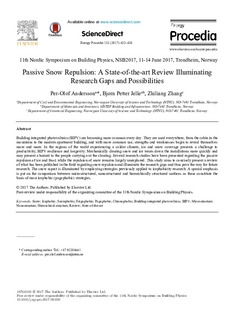| dc.contributor.author | Andersson, Per-Olof | |
| dc.contributor.author | Jelle, Bjørn Petter | |
| dc.contributor.author | Zhang, Zhiliang | |
| dc.date.accessioned | 2017-10-26T19:18:21Z | |
| dc.date.available | 2017-10-26T19:18:21Z | |
| dc.date.created | 2017-10-20T17:06:29Z | |
| dc.date.issued | 2017 | |
| dc.identifier.citation | Energy Procedia. 2017, 132 423-428. | nb_NO |
| dc.identifier.issn | 1876-6102 | |
| dc.identifier.uri | http://hdl.handle.net/11250/2462465 | |
| dc.description.abstract | Building integrated photovoltaics (BIPV) are becoming more common every day. They are used everywhere, from the cabin in the mountains to the modern apartment building, and with more common use, strengths and weaknesses begin to reveal themselves more and more. In the regions of the world experiencing a colder climate, ice and snow coverage presents a challenge to productivity, BIPV resilience and longevity. Mechanically clearing snow and ice wears down the installations more quickly and may present a hazard to the people carrying out the clearing. Several research studies have been presented regarding the passive repulsion of ice and frost, while the repulsion of snow remains largely unexplored. This study aims to concisely present a review of what has been published in the field regarding snow repulsion and illuminate the research gaps and thus pave the way for future research. The snow aspect is illuminated by employing strategies previously applied to icephobicity research. A special emphasis is put on the comparison between microstructured, nanostructured and hierarchically structured surfaces as these constitute the basis of most icephobic (pagophobic) strategies. | nb_NO |
| dc.description.sponsorship | Acknowledgements. This work has been supported by the Research Council of Norway (proj.no. 244031) under the ENERGIX program, along with several partners through the research project “Building Integrated Photovoltaics for Norway” (BIPV Norway). | nb_NO |
| dc.language.iso | eng | nb_NO |
| dc.publisher | Elsevier Ltd. | nb_NO |
| dc.rights | Attribution-NonCommercial-NoDerivatives 4.0 Internasjonal | * |
| dc.rights.uri | http://creativecommons.org/licenses/by-nc-nd/4.0/deed.no | * |
| dc.subject | Snow | nb_NO |
| dc.subject | Icephobic | nb_NO |
| dc.subject | Snowphobic | nb_NO |
| dc.subject | Frigophobic | nb_NO |
| dc.subject | Pagophobic | nb_NO |
| dc.subject | Chionophobic | nb_NO |
| dc.subject | Building integrated photovoltaic; BIPV | nb_NO |
| dc.subject | Microstructure | nb_NO |
| dc.subject | Nanostructure | nb_NO |
| dc.subject | Hierarchical structure | nb_NO |
| dc.subject | Review | nb_NO |
| dc.subject | State-of-the-art | nb_NO |
| dc.title | Passive Snow Repulsion: A State-of-the-art Review Illuminating Research Gaps and Possibilities | nb_NO |
| dc.title.alternative | 11th Nordic Symposium on Building Physics, NSB2017, 11-14 June 2017, Trondheim, Norway | nb_NO |
| dc.type | Journal article | nb_NO |
| dc.type | Peer reviewed | nb_NO |
| dc.description.version | publishedVersion | nb_NO |
| dc.rights.holder | © The Authors | nb_NO |
| dc.subject.nsi | VDP::Technology: 500 | nb_NO |
| dc.source.pagenumber | 423-428 | nb_NO |
| dc.source.volume | 132 | nb_NO |
| dc.source.journal | Energy Procedia | nb_NO |
| dc.identifier.doi | 10.1016/j.egypro.2017.09.650 | |
| dc.identifier.cristin | 1506379 | |
| dc.relation.project | Norges forskningsråd: 244031 | nb_NO |
| cristin.unitcode | 7401,30,0,0 | |
| cristin.unitname | SINTEF Byggforsk | |
| cristin.ispublished | true | |
| cristin.fulltext | original | |
| cristin.qualitycode | 1 | |

